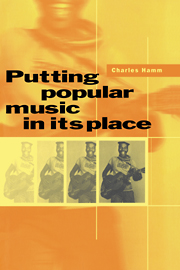Book contents
- Frontmatter
- Contents
- Acknowledgements
- Preface
- 1 Modernist narratives and popular music
- 2 Rock and the facts of life
- 3 Changing patterns in society and music: the US since World War II
- 4 “If I Were a Voice”: or, The Hutchinson Family and popular song as political and social protest
- 5 Some thoughts on the measurement of popularity in music
- 6 Elvis, a review
- 7 Home cooking and American soul in black South African popular music
- 8 Rock ‘n’ roll in a very strange society
- 9 African-American music, South Africa, and apartheid
- 10 “The constant companion of man”: Separate Development, Radio Bantu, and music
- 11 Privileging the moment of reception: music and radio in South Africa
- 12 Music and radio in the People's Republic of China
- 13 Towards a new reading of Gershwin
- 14 A blues for the ages
- 15 Graceland revisited
- 16 Dvořák in America: nationalism, racism, and national race
- 17 The last minstrel show?
- 18 The Role of Rock, a review
- 19 Genre, performance, and ideology in the early songs of Irving Berlin
- 20 Epilogue: John Cage revisited
- Index
13 - Towards a new reading of Gershwin
Published online by Cambridge University Press: 05 February 2012
- Frontmatter
- Contents
- Acknowledgements
- Preface
- 1 Modernist narratives and popular music
- 2 Rock and the facts of life
- 3 Changing patterns in society and music: the US since World War II
- 4 “If I Were a Voice”: or, The Hutchinson Family and popular song as political and social protest
- 5 Some thoughts on the measurement of popularity in music
- 6 Elvis, a review
- 7 Home cooking and American soul in black South African popular music
- 8 Rock ‘n’ roll in a very strange society
- 9 African-American music, South Africa, and apartheid
- 10 “The constant companion of man”: Separate Development, Radio Bantu, and music
- 11 Privileging the moment of reception: music and radio in South Africa
- 12 Music and radio in the People's Republic of China
- 13 Towards a new reading of Gershwin
- 14 A blues for the ages
- 15 Graceland revisited
- 16 Dvořák in America: nationalism, racism, and national race
- 17 The last minstrel show?
- 18 The Role of Rock, a review
- 19 Genre, performance, and ideology in the early songs of Irving Berlin
- 20 Epilogue: John Cage revisited
- Index
Summary
Six months after returning from my last trip to southern Africa, an invitation from Brooklyn College to lead a seminar on the music of George Gershwin shifted my attention back to the musical life of the United States.
As far back as 1945 my first professor of musicology, Steve Tuttle – gentle, Harvard-educated, passionately devoted to the great master-pieces of the classical repertory and with no apparent interest in popular music – had confessed to me that the music of Gershwin troubled him. Inclined by his education and musical tastes to dismiss it out of hand, he somehow kept coming back to it, attracted and repelled at the same time. I'd had somewhat of the same problem. Though I was fond of many of the songs and had found Porgy and Bess to be an outstanding piece of musical theater, Gershwin's orchestral compositions had always struck me as being unsatisfactory compromises between irreconcilable musical styles, or genres, or concepts.
This article, growing out of my first lecture for the seminar, sets out to identify and analyze the several strands of modernist thought that had shaped attitudes, mine included, towards Gershwin and his music. Though I wouldn't go so far as to suggest that Gershwin was a proto-postmodernist, some of the conceptual confusion surrounding him was clearly a reaction to his attempts to free music from the rigidity of modernist form and function.
- Type
- Chapter
- Information
- Putting Popular Music in its Place , pp. 306 - 324Publisher: Cambridge University PressPrint publication year: 1995



